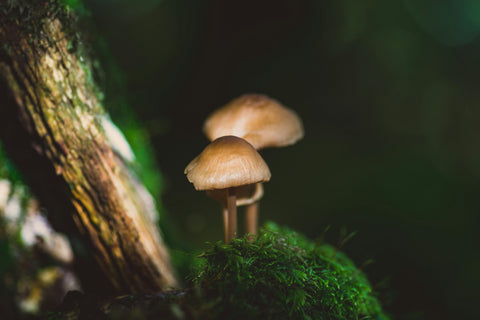Introduction: Colour you can hear
Every autumn, we watch green fade to gold, amber, and crimson. But how leaves change colour isn’t just a feast for the eyes—it also nudges the electrical rhythms inside a plant. Those tiny shifts are exactly what a Bluetooth biofeedback sensor like PlantChoir can translate into gentle, living sound.
In this science bite, we’ll keep it simple. You’ll learn why leaves change hue, what’s happening to pigments and sugars, and how these seasonal changes can subtly shape a plant’s bioelectric signals—the raw material for plant music. We’ll share easy, at‑home listening ideas for houseplants and provide links if you’d like to dive deeper.
The short version
Green leaves are loaded with chlorophyll, the pigment that helps turn light into energy.
As days shorten and nights cool, plants reclaim nutrients from leaves. Chlorophyll breaks down and other pigments—carotenoids (yellows/oranges) and sometimes anthocyanins (reds/purples)—shine through.
Behind the colour shift, cells are rebalancing water, sugars, and ions. Membranes and transport pumps work differently in cooler, darker conditions.
Those internal changes affect a leaf’s electrical properties. With a biofeedback sensor, you can often hear the season as subtle changes in dynamics, tempo‑like fluctuations, and note activity in your plant’s music.
Why leaves are green most of the year

Light, chlorophyll, and steady workdays
In spring and summer, leaves are factories. Chlorophyll absorbs light—especially red and blue wavelengths—and powers photosynthesis. The electron transport chain hums along, making sugars from carbon dioxide and water. The result is a stable, green canopy.
Carotenoids and a quiet supporting cast
Carotenoids (carotenes and xanthophylls) are present all season, quietly helping with light harvesting and photoprotection. They’re masked by the sheer abundance of chlorophyll. Think of them as backup singers waiting for their solo.
The autumn switch: a graceful shutdown

Shorter days, cooler nights
As day length drops, many trees and some houseplants begin a “shutdown protocol.” Hormonal cues signal leaves to resorb valuable nutrients, especially nitrogen from chlorophyll molecules. Chlorophyll breaks down first. With green fading, carotenoids reveal their warm yellows and oranges.
Where the reds and purples come from
In some species (maples are famous), sugars trapped in the leaf during cool, bright days can be converted into anthocyanins—the pigments that make reds and purples. These pigments may help shield aging tissues from excess light and oxidative stress, buying time for nutrient recovery. Researchers continue to debate the exact benefits, but the pattern is striking: bright days, cold nights, and a suite of crimson tones.
Brown at the end
By late autumn, all those lively pigments finally break down, leaving behind more stable tannins. That’s why many leaves finish their journey in shades of bronze and brown.
How colour relates to bioelectric signals (and music)
Leaves are electrical neighborhoods
Every living plant cell is an electrical scene: ions move across membranes, pumps and channels open and close, and tiny potentials rise and fall. Plants generate several kinds of electrical signals—rapid spikes after touch, slower waves after wounding or temperature shifts, and gentle, oscillating rhythms tied to metabolism, light, and water status.
Changing pigments = changing conditions
When chlorophyll breaks down and anthocyanins appear, it’s not just a paint job. The leaf is:
-
Rebalancing water and sugars. Cooler nights and shorter days change transpiration, sugar loading, and osmotic balances.
-
Adjusting photosynthesis. With less chlorophyll, light harvesting and photochemistry dial down.
-
Remodeling membranes. Senescence alters membrane permeability and ion transport.
All three influence the leaf’s electrical impedance (how easily electrical current passes) and surface potentials. That’s the same territory a plant biofeedback sensor listens to.
What you might hear with PlantChoir
PlantChoir translates fluctuations in conductance and potential into real‑time note events and instrument dynamics. As plants experience cooler, darker days or indoor seasonal shifts, you may notice:
-
Softer, sparser phrases during longer nights or after a cool snap.
-
Brighter bursts on clear, sunny days when photosynthetic activity flickers higher.
-
Slow, wave‑like patterns when a plant is adjusting water balance after a change in humidity or watering.
No two plants “perform” the same way. That’s part of the magic.
A closer look at the science (light, pigments, ions)

Chlorophyll breakdown and nutrient recycling
-
The why: Nitrogen is precious. As winter approaches, many plants pull nitrogen back from chlorophyll and store it in stems and roots.
-
The what: Less chlorophyll means green fades, revealing carotenoids. If sugars remain trapped in leaf tissues, the plant may synthesize anthocyanins that give reds and purples.
-
The effect on signals: Reduced photosynthetic throughput can mean slower ion pumping and different stomatal rhythms, changing the electrical “texture” you’ll hear.
Anthocyanins as shields—and a live debate
Anthocyanins are thought to shield senescing leaves from excess light and oxidative stress. They likely help plants recover nutrients more safely. Not all scientists agree on the size of this effect for every species; in some maples, for instance, red pigments don’t always deliver strong protection. The bigger picture: autumn colour is a balancing act between light, cold, and nutrient recovery. Your ears might capture the process more than the pigment itself.
Electrical impedance and leaf water content
Electrical impedance in a leaf is shaped by water content, membrane integrity, and ion concentrations. Cool, dry air and shorter days can shift all three. That’s why seasonal transitions sometimes bring steadier, lower‑energy passages in plant music—especially at night—followed by livelier sequences when light returns or humidity rises.
Try this at home: an autumn listening ritual
Whether you have a spider plant in a bright kitchen or a peace lily in a cozy office, you can explore seasonal sound.
What you’ll need
-
A healthy indoor plant or small potted shrub near a window.
-
PlantChoir device and app (Bluetooth biofeedback, 40 instruments, eight musical scales).
-
A simple log (paper notebook or notes app).
Weekly listening prompts
-
Morning vs. evening: Record 5 minutes at sunrise and again after dusk. Compare phrase density and dynamic range.
-
Sunny vs. cloudy: Listen on a bright day and a dim one. Are there more note events when the sun hits the leaf?
-
Cool nights: On the first crisp evening, capture a 10‑minute session. The next warm afternoon, record again. How does the texture change?
-
Colour change (if you have deciduous patio plants): As colour shifts from green to yellow or red, listen weekly. Note any trend in tempo‑like fluctuations.
Gentle guidelines
-
Keep leaves dry where the clip attaches.
-
Avoid freshly damaged or heavily senescing leaves—they can be electrically noisy but fragile.
-
If a plant appears stressed, pause and resume once it recovers.
Best houseplants for seasonal listening
Some classic indoor plants offer clear, lively signals and tolerate frequent gentle clipping:
-
Monstera deliciosa – Big, sturdy leaves make clipping easy; fun, spacious music lines.
-
Snake plant (Sansevieria/Dracaena) – Thick blades, steady rhythms, low maintenance.
-
Pothos (Epipremnum) – Responsive to light changes near windows.
-
Peace lily (Spathiphyllum) – Noticeable responses to watering cycles.
If you keep small patio deciduous plants (dwarf maple, blueberry, or herbs like basil in shoulder seasons), colour change can be dramatic. Capture a few minutes each week as the hues shift.
How PlantChoir turns biofeedback into music
-
High‑resolution sensing. Enhanced sensor with 1500% higher resolution for cleaner signals.
-
Gold‑plated connectors. Gentle, stable contact with the leaf surface.
-
App instruments and scales. Choose from 40 instruments and eight scales; assign up to four instruments per plant.
-
Portable and long‑lasting. Lightweight, water‑resistant, and a 4–6 week battery life.
-
Compose, record, and share. Save performances, compare sessions, and send clips to friends—no subscriptions.
How it works: PlantChoir overview • Setup tutorial • Use cases at home and events
A season you can see—and hear
The colour of autumn is more than a show. It signals a slower, wiser phase of plant life—recycling nutrients, balancing sugars, and easing into rest. Those shifts also touch the plant’s electrical heartbeat. With PlantChoir, you can sit by a window, sip tea, and listen as your houseplant translates the season into sound—quiet, responsive, and always a little surprising.
Ready to begin?
Try PlantChoir today and start a seasonal listening ritual at home.
For the curious: what researchers observe
If you’d like to peek into the literature, here are a few notable threads:
-
Anthocyanins and red autumn leaves. Several studies argue that red pigments can shield senescing tissues from excess light and oxidative stress, aiding nutrient recovery. Others find weaker effects in certain species. The takeaway: colour is a nuanced strategy shaped by light and temperature.
-
Electrical signals and light cycles. Experiments show that leaves generate slow changes in electrical potential with alternating light and dark—likely reflecting ion pumps and channels adjusting to energy availability.
-
Impedance and physiology. Electrical impedance spectroscopy links leaf water status, membrane integrity, and chlorophyll content to measurable electrical properties—exactly the kind of dynamics that a biofeedback device can sense.
External sources (further reading)
-
Feild, T. S., et al. “Why Leaves Turn Red in Autumn.” Plant Physiology (2001).
-
Renner, S. S., & Zohner, C. “The occurrence of red and yellow autumn leaves explained by plant–environment interactions.” New Phytologist (2019).
-
Fensom, D. S. “Some daily and seasonal changes in the electrical potential and resistance of living trees.” Canadian Journal of Botany (1963).
-
Li, J., et al. “Illumination/Darkness‑Induced Changes in Leaf Surface Electrical Potential.” Frontiers in Plant Science (2019).
-
Muñoz‑Huerta, R. F., et al. “Electrical Impedance Measurements in Plants.” Sensors (2014).




